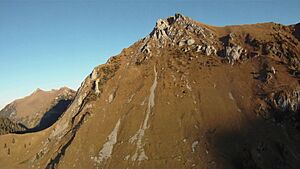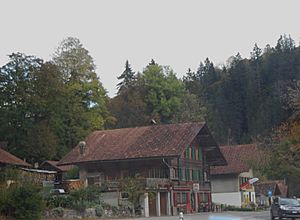Oberwil im Simmental facts for kids
Quick facts for kids
Oberwil im Simmental
|
||
|---|---|---|
|
||
| Country | Switzerland | |
| Canton | Bern | |
| District | Frutigen-Niedersimmental | |
| Area | ||
| • Total | 46.06 km2 (17.78 sq mi) | |
| Elevation | 836 m (2,743 ft) | |
| Population
(Dec 2020 )
|
||
| • Total | 804 | |
| • Density | 17.455/km2 (45.21/sq mi) | |
| Postal code |
3765
|
|
| Surrounded by | Boltigen, Därstetten, Diemtigen, Guggisberg, Plaffeien (FR), Rüschegg | |
Oberwil im Simmental is a small town, also called a municipality, in the Frutigen-Niedersimmental area of the canton of Bern in Switzerland. It's a lovely place located in the beautiful Simmen valley.
Contents
History of Oberwil im Simmental
Oberwil was first written about in the year 1278. Back then, it was called Oberwile.
Early Human Life in Oberwil
Long, long ago, during the Paleolithic era (about 20,000 to 10,000 BC), people lived in caves above the valley. They used these caves, like Schnurenloch and Mamilchloch, during the summer months. Inside these caves, scientists found about 5,000 bones from cave bears. These bears are now extinct, meaning they no longer exist. The people living there had hunted and prepared the bears.
Even though no human bones were found, many stone tools were discovered. These tools and bones are now kept at the Historical Museum of Bern. You can even visit these caves with a tour group today! People continued to use these caves and other nearby rock shelters through different time periods, including the Neolithic (New Stone Age), the late Bronze Age, and into the Middle Ages.
After the collapse of the Western Roman Empire, a group of people called the Alamanni settled in the Simmen valley. They built villages and used the mountain pastures for their animals.
Ownership and Changes Over Time
In 994, a royal estate in Wimmis and part of Oberwil were given to a place called Selz Abbey in Alsace. Later, in 1276, Wimmis and Oberwil were given to a new Augustinian Därstetten priory (a type of monastery).
During the Middle Ages, two castles, Festi and Heidenmauer, were built high above the valley. Sadly, there are no records left about these castles, and they are now just ruins. By the 12th century, the remaining lands and settlements were owned by a noble family called the Freiherr von Weissenburg.
In 1439, all the lands belonging to the Weissenburg family, including Oberwil, were bought by the city of Bern. In the 16th century, the entire Simmen valley changed how it made a living. Instead of just growing enough food for themselves (called subsistence agriculture), people started raising cattle and making cheese from milk. Even today, farming is the main industry in Oberwil, though there are also small businesses and tourism.
The Village Church
The village church, named St. Mauritius, was built by the Freiherr von Weissenburg family. It was first mentioned in records in 1228. The church was made bigger in the 14th and 15th centuries.
Geography of Oberwil im Simmental
Oberwil im Simmental covers an area of about 46 square kilometers (17.7 square miles). A big part of this land, about 51.4%, is used for farming. Forests cover about 33.8% of the area.
A smaller part, about 2.5%, has buildings or roads. Rivers and lakes make up 0.6%, and 11.5% is land that can't be used for farming or building, like rocky areas.
The town is spread out across the Simmental (Simmen valley). It also includes the meadows and forests of the mountains around it. Oberwil is made up of several farming communities called Bäuerten, including Oberwil, Hintereggen, Pfaffenried, Bunschen, and Waldried.
In 2010, the old district of Niedersimmental was changed. Oberwil then became part of the new Frutigen-Niedersimmental area.
Coat of Arms
The blazon (description) of Oberwil's coat of arms is: "Per fess Argent a Castle Gules and Vert." This means it has two main parts. The top part is silver with a red castle, and the bottom part is green.
People of Oberwil im Simmental (Demographics)
Oberwil im Simmental has a population of about 794 people (as of December 2011). A small number of these people, about 3.6%, are foreign nationals living in the town. Over the last ten years, the population has slightly decreased.
Most people in Oberwil (about 99.1%) speak German as their main language. A very small number speak French or Romansh.
In 2008, the population was almost evenly split between men and women. About 64% of the people living in Oberwil in 2000 were also born there. Most of the rest were born in the same canton (Bern).
Age Groups and Households
In 2011, young people (0–19 years old) made up about 20.3% of the population. Adults (20–64 years old) were 55.7%, and seniors (over 64 years old) were 24.1%.
In 2010, there were 83 households with only one person. There were also 28 households with five or more people. Most apartments in 2000 were lived in all year round.
The chart below shows how the population of Oberwil has changed over many years:

Important Heritage Sites
The Venner house in Oberwil is very special. It is listed as a Swiss heritage site of national significance. This means it's an important historical or cultural place for the whole country. The entire village of Oberwil im Simmental and the small community (or hamlet) of Pfaffenried are also part of the Inventory of Swiss Heritage Sites.
Economy of Oberwil im Simmental
In 2011, the unemployment rate in Oberwil im Simmental was very low, at 0.73%. This means almost everyone who wanted a job had one.
Jobs and Industries
In 2008, 349 people worked in Oberwil.
- Many people (220) worked in the primary economic sector. This mostly means farming, like raising animals and growing crops.
- About 65 people worked in the secondary sector. This includes manufacturing (making things) and construction (building things).
- About 64 people worked in the tertiary sector. This involves services, like working in shops, hotels, restaurants, or transportation.
Many people who live in Oberwil also work there. However, more people leave the municipality to work elsewhere than those who come in to work.
Taxes and Income
In 2011, the average tax rate for a married person with two children in Oberwil was 12.7%. For an unmarried person, it was 18.7%. These rates are similar to the average for the whole canton of Bern.
In 2011, a small number of people (1.1% of the population) received financial help from the government.
Religion
According to a census in 2000, most people in Oberwil (86.2%) belonged to the Swiss Reformed Church. A smaller number (1.7%) were Roman Catholic. There were also people who belonged to other Christian churches or no church at all.
Transport
Oberwil im Simmental is on the Spiez–Zweisimmen railway line. It has two train stations: Oberwil im Simmental and Enge im Simmental railway station. This makes it easy for people to travel to and from the town.
Education
In Oberwil im Simmental, about 44.5% of adults have finished non-mandatory upper secondary education. This is like high school. About 5.3% have gone on to higher education, like university or a specialized college.
School System in Bern
The school system in the Canton of Bern works like this:
- First, there's one year of non-required Kindergarten.
- Then, six years of Primary school.
- After that, three years of required lower Secondary school. In this stage, students are grouped based on their abilities.
- After lower Secondary, students can choose to continue their schooling or start an apprenticeship (learning a trade on the job).
During the 2011-2012 school year, 63 students attended classes in Oberwil im Simmental. There was one kindergarten class with 7 students, two primary classes with 47 students, and one lower secondary class with 9 students.
Most students who lived in Oberwil also went to school there. However, some students from Oberwil went to schools outside the municipality.
See also
 In Spanish: Oberwil im Simmental para niños
In Spanish: Oberwil im Simmental para niños







